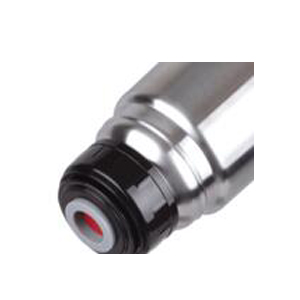Home > Blog > How to clean the vacuum flask…
How to clean the vacuum flask

Ah the humble flask. Many of us use thermal or Vacuum Flasks to get our hot drink fix on-the-go. They’re also undeniably handy for picnics and carrying soup on colder days. This is great for cutting down on single-use plastic (and saving us some cash at the same time).
However, you will need to clean your flask after each use, and the narrow neck can make it a little awkward to clean. While a quick wash is fine most days, you’ll want to give it a thorough clean now and then to keep mould, bacteria and nasty niffs away. Here’s how to clean a flask.
Cleaning a flask with washing up liquid
Before you start, do check for any manufacturer’s guidelines (if you’ve chucked them away, have a look on the brand’s website).
- Take off the cup and stopper.
- Pour away any liquid that’s left in the flask.
- Give it a quick rinse.
- Don’t soak the flask, as submerging it in water for a long period of time can damage it.
- Using warm water and a mild washing-up liquid, wash both the interior and exterior of your flask. You might be able to use a soft cloth or sponge. However, if the neck is too narrow to get your hand in, you’ll need to use a soft-bristled bottle brush or toothbrush.
- Rinse thoroughly to remove all traces of washing-up liquid. It’s best to do this using hot, running water.
How to clean a Thermos flask stopper
A flask stopper being cleaned with a toothbrush
Some stoppers can be washed in the dishwasher. If yours can’t, use a mild washing up liquid and an old soft bristled toothbrush to clean it. Make sure you get in all the crevices. And rinse it thoroughly, or your next latte could taste rather soapy.
You won’t be able to reach some parts of the stopper, so it’s a good idea to give the whole thing an extra good clean sometimes, using a teaspoon of baking soda dissolved in a cup of warm water, and that soft bristled toothbrush.
Don’t forget to wash the cup out, too. Follow the steps for cleaning your flask that we’ve set out above.
A flask,Stopper and cup drying beside a sink
If you have time, allow your flask, stopper and cup to drain and air-dry. Open up the stopper to allow air to circulate. Then, use a clean towel to dry off any excess liquid. Make sure it’s completely dry before you put it away.
How to dry a flask
How to clean a flask with bicarbonate of soda
-
First off, wash the flask using the steps above.
-
Then fill it with boiling water.
-
Add a teaspoon of bicarbonate of soda (also known as baking soda).
-
Screw the stopper back on and leave it for at least an hour. (You might want to leave it overnight if the flask is really stained or smelly.)
-
Tip the water away
-
Rinse thoroughly.
How to clean a Thermos flask with vinegar
-
Pour half a cup of white vinegar into your dry flask.
-
Give it a really good shake, (pretend you’re making your favourite cocktail).
-
Leave it for 20 minutes.
-
Pour the vinegar out.
-
Rinse thoroughly.
Cleaning a flask with rice
Uncooked rice can be your secret weapon for cleaning a flask as it can get into those hard to reach edges.
- Half fill the flask with cold water.
- Add a couple of tablespoons of rice.
- Shake it for a few minutes.
- Empty the rice and water into a sieve so the rice doesn’t block your drain.
- Rinse.
How to wash a flask in a dishwasher
If your flask is dishwasher-safe, take the top off and open up the spout. Put the stopper and cup on the top rack of the dishwasher, facing whichever way is best in order for them to not collect water.
Manufacturers tend to recommend putting the main flask on the top rack too, but it probably won’t fit. If you want to risk putting it on the bottom rack, make sure you don’t use the highest temperature.
How to get limescale off a flask
-
Fill your flask with boiling water.
-
Add a teaspoon of citric acid.
-
Leave it for half an hour.
-
Pour the water away.
-
Rinse thoroughly.
How to keep your flask working at its best
-
DO check the manufacturer's advice before you wash it.
-
DO wash your flask before you first use it, and after every use.
-
DO use baking soda or vinegar for stains.
-
DO pre-fill your flask with either hot or cold water (depending on what you want to use it to store) for around three minutes before use.
-
DO make sure your flask is dry before you put it away.
-
-
DO store your flask with the stopper off.
-
DON’T overfill your flask. This could lead to leaks and damage to the stopper.
-
DON’T use any abrasive, solvent or bleach-based cleaners.
-
DON’T submerge the flask in water for long.
-
Products Category
Latest News
Contact Us
Name: Wendy
Mobile:13486957322
Tel:+86 13486957322
Whatsapp:13486957322
Email:sales@yybottle.com
Add:No 27,MuDan Road,BaiHuaShan Industrial Area,BaiYang Street,WuYi,ZheJiang 321200,China
